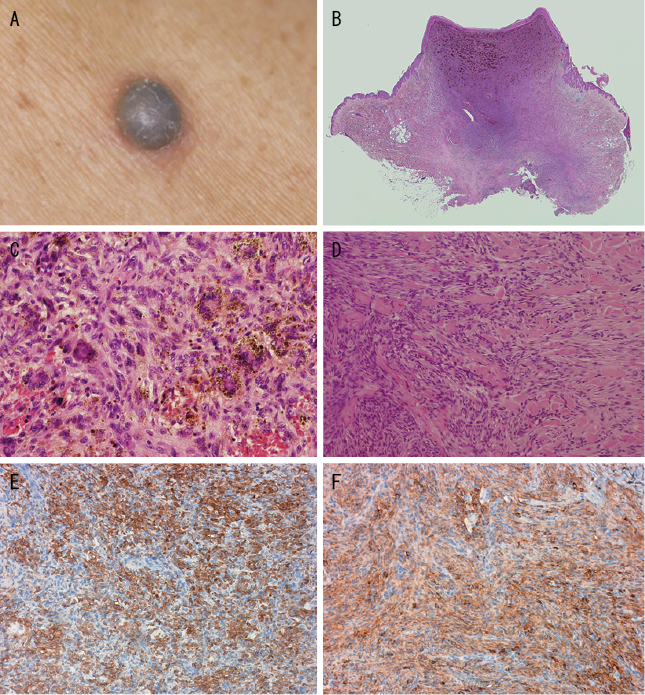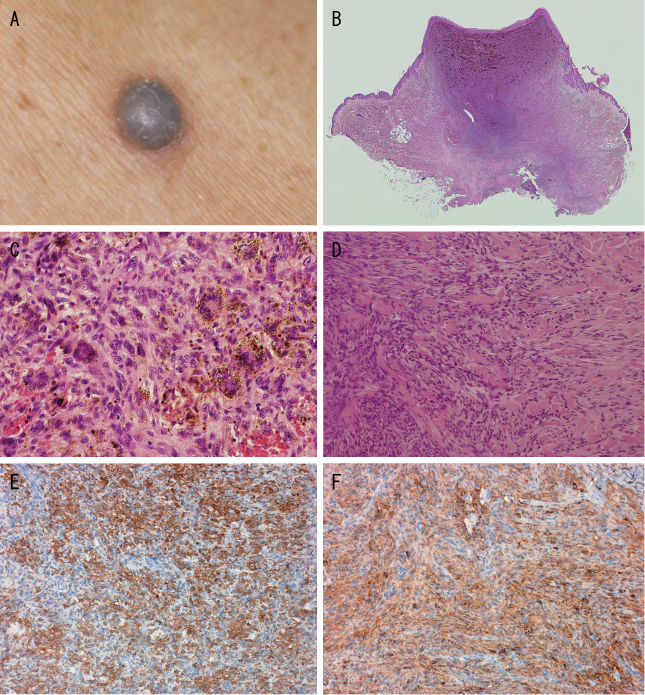Kanako Tsunoda1, Kazuhiro Takahashi1, Fumihiko Maeda1, Hiroki Oikawa2 and Toshihide Akasaka1
Departments of 1Dermatology and 2Pathology, School of Medicine, Iwate Medical University, Uchimaru 19-1, Morioka 020-8505, Japan. E-mail: ktakami@iwate-med.ac.jp
Accepted Dec 3, 2012; Epub ahead of print Mar 5, 2013
Atypical fibrous histiocytoma (AFH) is a variant of dermatofibroma (DF) that was first described by Fukamizu et al. (1) in 1983. Histologically AFH is characterized by proliferation of dermal spindle cells composed mainly of atypical histiocytic cells with striking nuclear pleomorphism and atypia, in a background of classic fibrous histiocytoma (2). It is known that many cases of AFH follow a benign course if complete excision is carried out (2, 3). However, because the tumour cells are atypical, AFH must be differentiated from tumours of intermediate malignancy, such as dermatofibrosarcoma protuberans (DFSP) or atypical fibrous xanthoma (AFX), as well as more malignant tumours, such as pleomorphic dermal sarcoma (PDS)/malignant fibrous histiocytoma (MFH).
We report here a case of AFH on the left upper arm of a 63-year-old woman and describe its immunoreactivity in detail. We also discuss the points of histological and immunohistological differentiation between AFH and other cutaneous spindle cell tumours.
CASE REPORT
A 63-year-old woman presented with an 8-month history of a symptomless, slowly growing swelling on the left upper arm. The patient had no unusual medical or family history. Clinical examination revealed an 8-mm black-purplish hard mass with peripheral erythema (Fig. 1A). The tumour had arisen at a site without any known previous history of injury. A haemangioma was clinically suspected, and surgical excision was performed. Microscopic examination revealed a well-defined lesion, located in the dermis and extending to the subcutaneous tissue, with epidermal hyperplasia and a grenz zone (Fig. 1B). The lesion was composed largely of interlacing fascicles of predominant histiocyte-like eosinophilic spindle cells with elongated or plump vesicular nuclei, arranged in a storiform pattern. Abundant pleomorphic giant cells with huge bizarre nuclei (bi-lobed and multi-lobed) and histiocytes with large vesicular nuclei and prominent eosinophilic nucleoli were observed (Fig. 1C). In the peripheral region of the tumour, fibroblast-like spindle cells arranged in a storiform or fascicular pattern with collagen bundles were observed, resembling the classic features of DF. No necrosis was present. Foci of chronic inflammatory cells, including lymphocytes and plasma cells, were also evident. As a typical feature, we noted individual prominent hyalinized collagen bundles surrounded by tumour cells, predominantly in the periphery of the lesion (Fig. 1D). The mitotic count was 3 per 10 high-power fields (HPF).
Immunohistochemical staining revealed diffuse positivity for vimentin, factor XIIIa, CD68, CD163 (Fig. 1E) and CD44 (Fig. 1F). The lesion showed no reactivity for desmin, CD34, AE1/AE3, desmin, S-100 protein, α1-antitrypsin or α1-antichymotrypsin. Ki-67 staining showed less than 5% positive reactivity. Based on these findings, a diagnosis of atypical fibrous histiocytoma was made. As it was suspected that the initial resection may have left some residual tumour cells at depth, expanded excision with a 3-cm margin was performed one month later. At 30 months of follow-up, the patient was asymptomatic with no evidence of tumour recurrence.

DISCUSSION
The distinctive histological features of AFH include a dermal lesion extending into superficial subcutaneous adipose tissue, composed of a population of pleomorphic spindled (fibroblast-like) and polyhedral (histiocyte-like) cells admixed with multinucleated giant cells, and macrophages as well as hemosiderin deposits. Kaddu et al. (2) reported the presence of 1–15 pathologic mitoses per 10 high power field (HPF) (mean 3.4 per 10 HPF) (20/59 cases, 33.9%) and/or geographic-like necrosis (7/59 cases, 11.9%) (2). Many reports have indicated positivity for factor XIIIa (4–6), but negativity has also been reported in some cases (2, 7, 8). Garrido-Ruiz et al. (6) and Wilk et al. (8) reported that AFH was CD34-negative. Although AFH of the skin is considered to be benign, there have been rare cases of multiple recurrence involving metastasis to the lymph nodes and lungs (2, 3, 5). Kaddu et al. (2) reported local recurrence in 3 of 21 cases for which follow-up was possible, and among these cases, distant metastasis occurred in 2. These 3 cases were all incompletely excised. Therefore, complete excision of AFH with a sufficient margin is important.
Histologically, the differential diagnosis of AFH includes DFSP, AFX and PDS/MFH. DFSP commonly occurs on the body trunk or proximal limbs of healthy adults, showing uniform bland spindle cells with spindle-shaped nuclei exhibit a storiform pattern and proliferate from the dermis to the subcutaneous adipose tissue with an unclear boundary, CD34 is diffusely positive, and immunoreactivity for α-SMA and desmin are usually negative (3, 9). In our case, as the tumour cells were notably polymorphic, CD34 was negative, and typical features of DF were observed in the background. AFX commonly occurs in sun-damaged skin of the head and neck in elderly individuals. AFX is similar to AFH in showing proliferation of spindle cells as well as multinucleated giant cells and bizarre cells (2). However, solar elastosis is observed in AFX, and a grenz zone is not evident because the tumour cells proliferate from directly under the skin. Moreover, features of typical DF are not observed (3). PDS/MFH commonly occurs in the limbs of middle-aged individuals, and it is common for the lesion to extend deeply into subcutaneous tissue, thus commonly forming a large tumour. An important point is that the tumour cells with profound atypia proliferate, and immunohistochemically do not demonstrate a specific line of differentiation. α1-antitrypsin and α1-antichymotrypsin are immunohistochemically positive in PDS/MFH (10). In the present case, the tumour cells were negative for both α1-antitrypsin and α1-antichymotrypsin, and atypia of the proliferating cells was not as severe as that in PDS/MFH.
Recent studies have shown that CD163 and CD44 are specific for DF and its variants. CD163, a haemoglobin scavenger receptor expressed by monocytes and tissue macrophages, is reportedly expressed in DF (89%) and cellular fibrous histiocytoma (100%), whereas it is negative in DFSP (83%) (11) and AFX (100%) (12). In addition, CD44 is the cell surface receptor for hyaluronate, and has also been reported to be a useful diagnostic marker of DF (13). In our case, the tumour cells showed strong expression of both CD163 and CD44, thus supporting the contention that AFH is a variant of DF.
ACKNOWLEDGEMENTS
The authors thank Professor Hiroshi Hashimoto, Department of Pathology, University of Occupational and Environmental Health, Japan, for his helpful comments on this case.
REFERENCES

Fig. 1. (A) Macroscopic view of the blackish-purplish skin tumour on the right arm. (B) Dermal-to-subcutaneous tumour with focal extension into the subcutaneous tissue. The epidermis was hyperplastic and a grenz zone was evident (haematoxylin and eosin; HE × 1). (C) The tumour is composed of a proliferation of interlacing fascicles of predominantly histiocyte-like eosinophilic spindle cells with vesicular nuclei. Abundant pleomorphic giant cells with huge bizarre nuclei are present (HE × 100). (D) At the border of the lesion, the cells are interspersed with hyaline collagen bundles (HE × 40). Immunohistochemical studies of the tumour cells. The cells were positive for (E) CD163 and (F) CD44.
